Traditional Lancashire Hot Pot
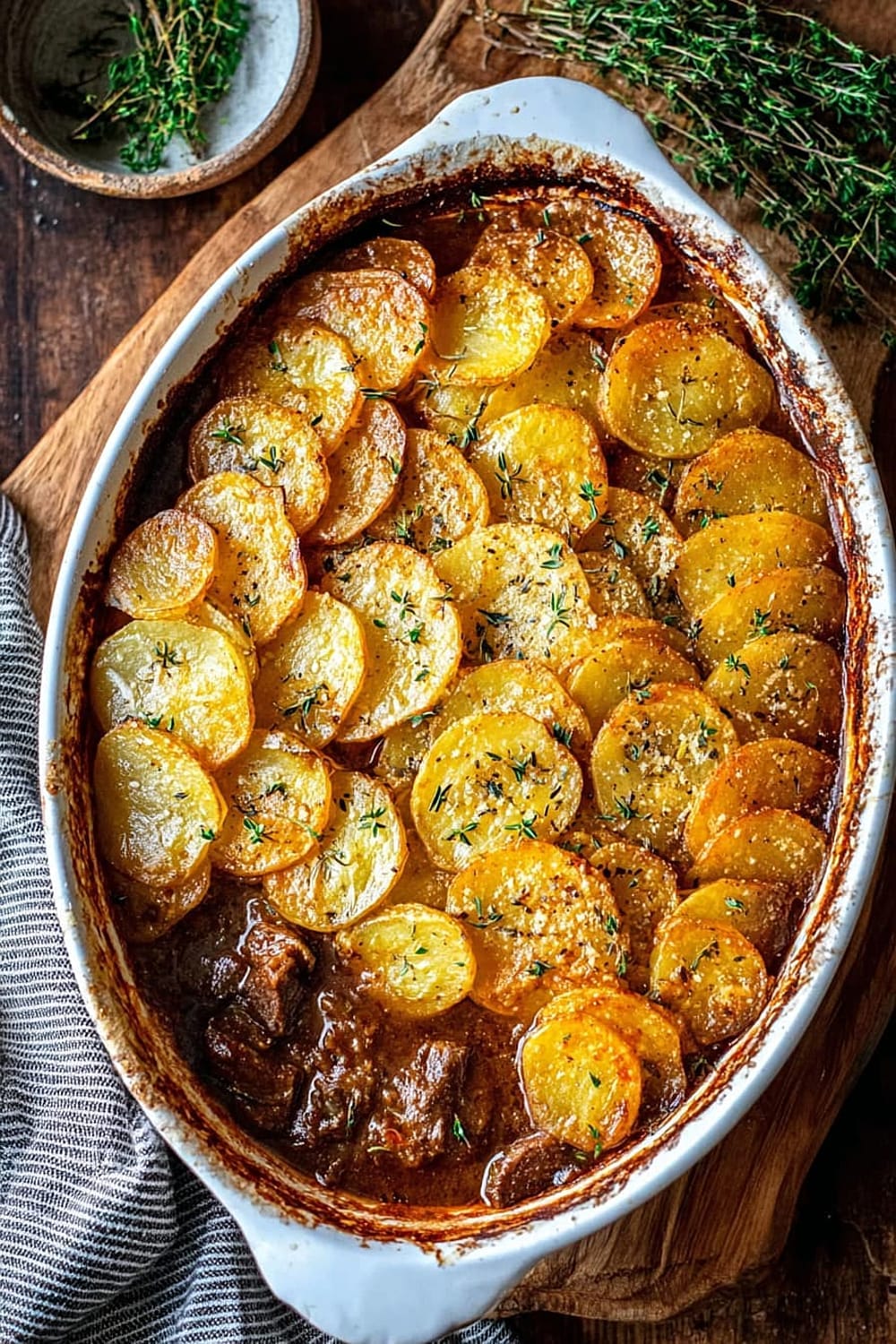
This is the kind of comfort food that makes your kitchen smell like a warm hug and your neighbors suddenly very interested in being your best friend.
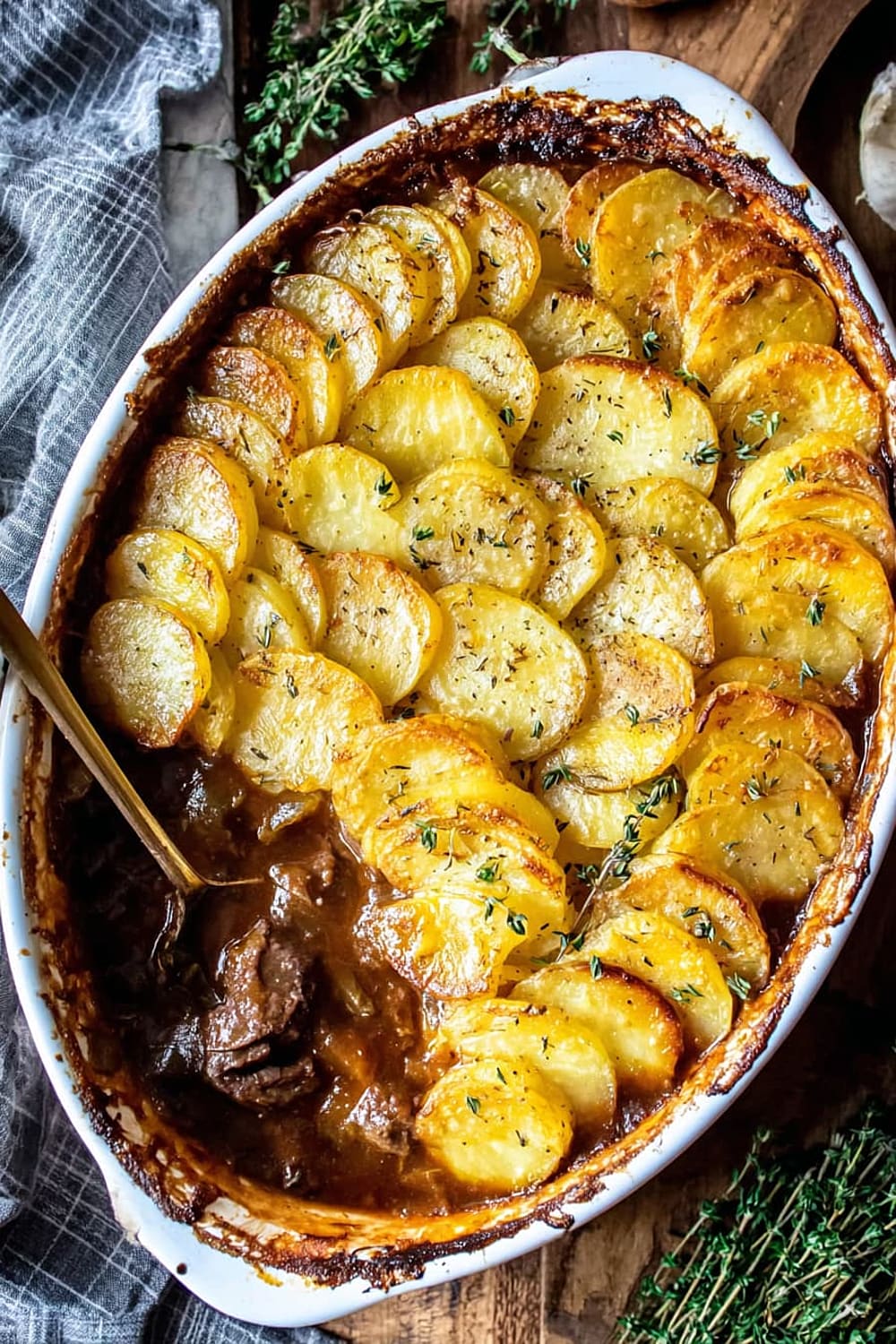
Picture tender chunks of lamb melting in your mouth while perfectly layered potatoes create that magical combination of fluffy underneath and golden crispy on top that food dreams are made of.
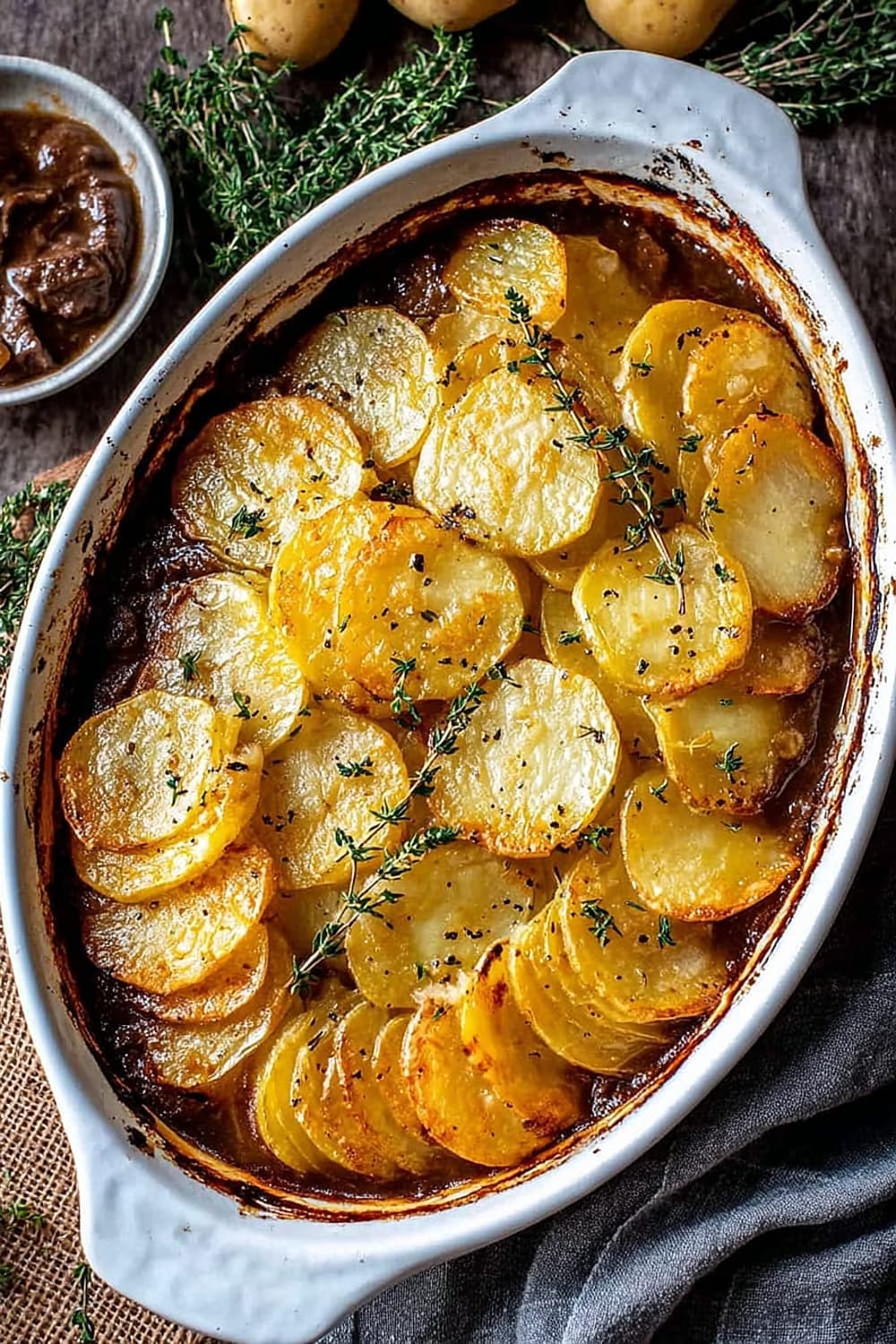
Lancashire Hot Pot isn’t just dinner – it’s basically a masterclass in how to make simple ingredients do extraordinary things without breaking a sweat or your budget.
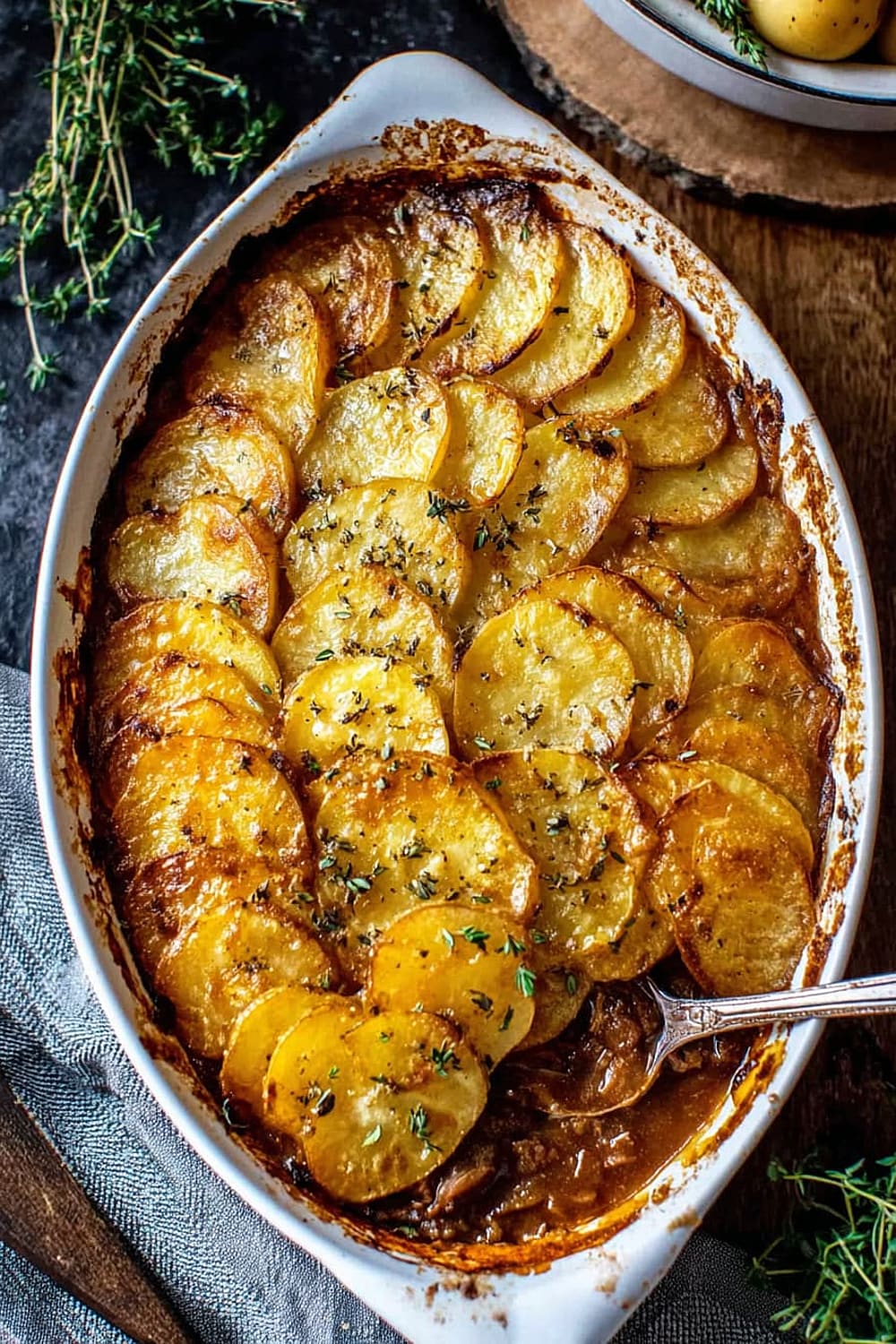
The beauty of this traditional British dish lies in its brilliant simplicity: everything goes into one dish, the oven does most of the work, and you get to look like a culinary genius.
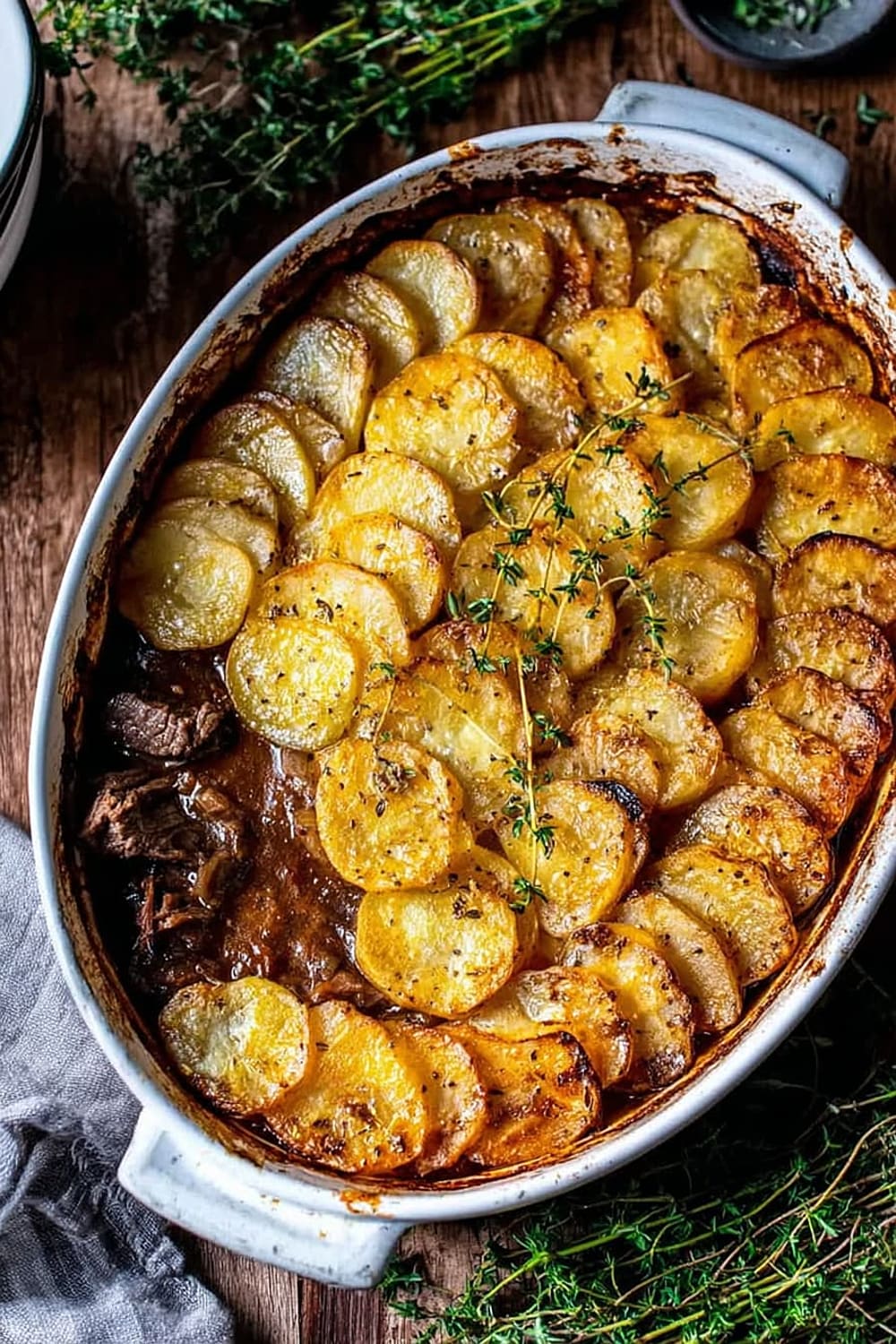
That moment when you lift the lid and see those gorgeously bronzed potato slices sitting atop rich, savory lamb gravy is pure kitchen magic that never gets old.
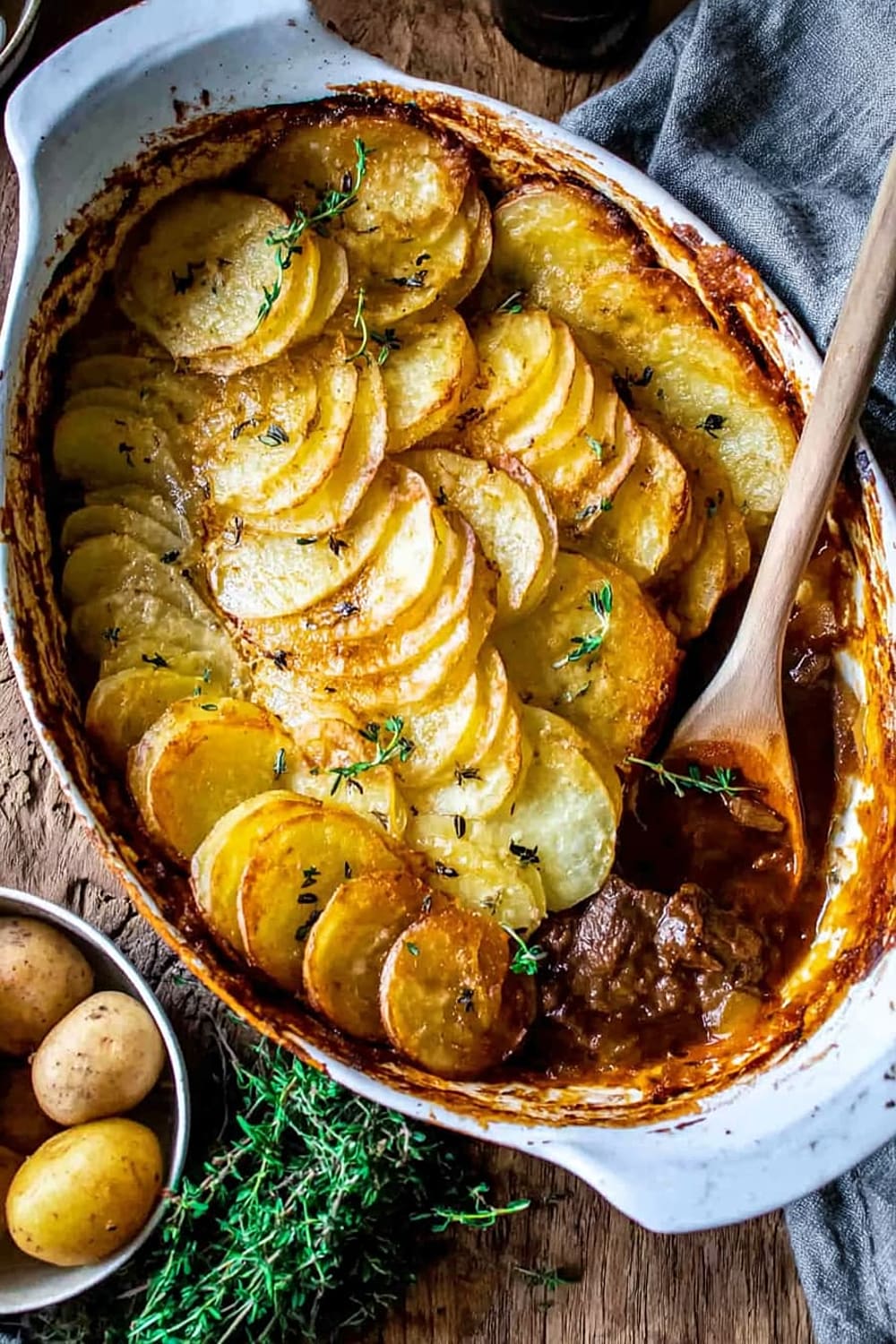
Fair warning: making this will result in people asking for the recipe, seconds, and possibly showing up unannounced around dinnertime.
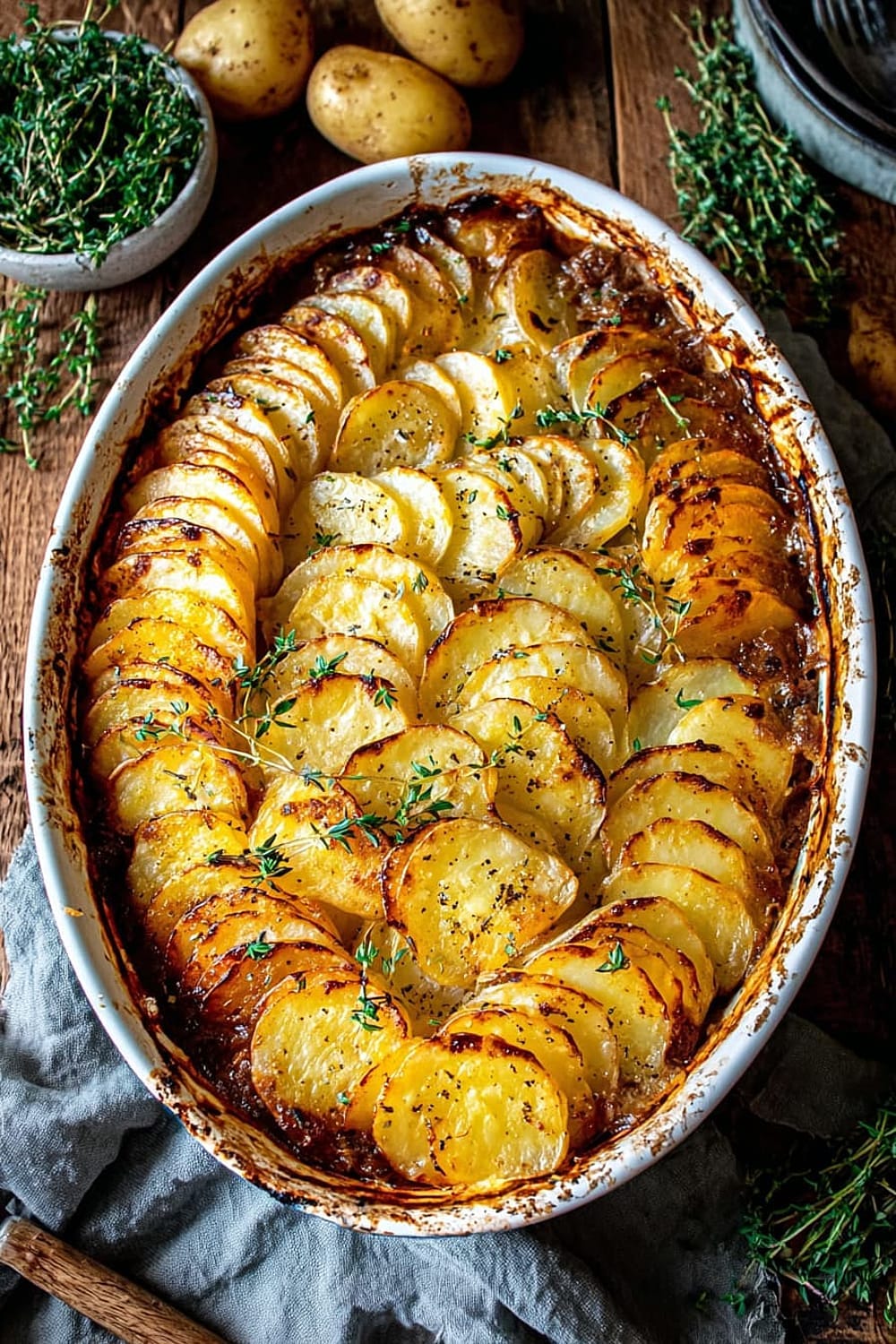
Ingredients
For the lamb base
- 1 tablespoon butter
- 1 tablespoon vegetable oil
- 500 g (1.1 lbs) lamb – not too lean, neck is best but shoulder works beautifully too, cut into bite-size chunks
- 2 brown onions – peeled and sliced thinly
For the gravy
- 1 heaped tablespoon plain flour – use gluten-free if required
- 480 ml (2 cups) hot chicken or vegetable stock – water with stock cubes works fine, or use bouillon for gluten-free
- 2 bay leaves
- ½ teaspoon salt
- ½ teaspoon ground black pepper
- 1 tablespoon Worcestershire sauce – use gluten-free version if needed
For the vegetables
- 3 medium-sized carrots – peeled and cut into chunks
- 680 g (1.5 lbs) potatoes – peeled and sliced to 2-3mm thick (floury potatoes like Maris Pipers work best)
For the topping
- 1 tablespoon melted butter for brushing
- ¼ teaspoon dried thyme
Instructions
Preparation
- 1 Preheat your oven to 170°C/325°F (fan). This moderate temperature ensures the lamb becomes tender while preventing the potatoes from burning during the long cooking process.
- 2 Heat the 1 tablespoon butter and 1 tablespoon vegetable oil in a medium-sized casserole dish or heavy-bottomed saucepan over medium-high heat until the butter melts and begins to foam. The combination of butter and oil prevents burning while adding rich flavor.
Building the base
- 3 Add the 500g lamb chunks to the hot fat and fry until lightly browned all over, about 3-4 minutes. You’re not cooking the lamb through – just developing that crucial caramelized flavor that forms the foundation of great gravy. Use tongs to turn the pieces for even browning.
- 4 Remove the browned lamb to a bowl using a slotted spoon, leaving those flavorful browned bits in the pan. Add the 2 sliced onions to the same pan and cook for 3-4 minutes, stirring regularly with a wooden spoon, until they become soft and translucent.
Creating the gravy
- 5 Return the lamb to the pan with the onions, then sprinkle over the 1 heaped tablespoon flour. Stir everything together and cook for 1 minute – this cooks out the raw flour taste and helps thicken your gravy beautifully.
- 6 Gradually add the 480ml hot stock, stirring constantly to prevent lumps from forming. Add the 2 bay leaves, ½ teaspoon salt, ½ teaspoon black pepper, and 1 tablespoon Worcestershire sauce. Give everything a good stir and bring to a gentle bubble, then cover with a lid and transfer to the preheated oven for 30 minutes.
Adding vegetables and assembly
- 7 After 30 minutes, remove from the oven and stir in the 3 chunked carrots. At this point, you can transfer everything to a 25cm diameter pie dish if you prefer – this helps with the final presentation and makes serving easier.
- 8 Arrange the sliced potatoes over the lamb mixture in overlapping layers, starting from the outside edge and working toward the center. This traditional pattern ensures even cooking and that gorgeous presentation Lancashire Hot Pot is famous for.
Final cooking
- 9 Brush the potato surface with the 1 tablespoon melted butter and sprinkle evenly with the ¼ teaspoon dried thyme. Cover with a lid or aluminum foil and return to the oven for 1 hour.
- 10 After 1 hour, increase the oven temperature to 200°C/400°F (fan) and remove the lid or foil. Cook for a further 30 minutes until the potatoes are beautifully golden brown and crisp on top while remaining fluffy underneath.
- 11 Remove from the oven and let rest for 5 minutes before serving – this allows the gravy to settle and prevents molten-hot disasters. Serve with fresh green vegetables like steamed broccoli or buttered peas.
Recommended Equipment and Kitchen Tools
Recommended Tools (for best results)
- Heavy-bottomed casserole dish – ensures even browning and heat distribution, preventing hot spots that could burn your lamb or onions
- Sharp knife – essential for achieving those perfectly thin, even potato slices that create the signature layered top
- Wooden spoon – ideal for stirring the flour into the lamb mixture without scratching your cookware
- Slotted spoon – makes transferring the browned lamb clean and easy while leaving flavorful drippings behind
Helpful Upgrades
- Mandoline slicer – creates consistently thin potato slices for professional-looking results and even cooking
- Cast iron Dutch oven – retains heat beautifully and can go from stovetop to oven seamlessly, plus it looks gorgeous for serving
- Instant-read thermometer – helps ensure your lamb reaches the perfect tenderness without overcooking
Nice-to-Have Options
- Kitchen scale – for precise measurements, especially helpful when scaling the recipe up or down for different crowd sizes
- Pastry brush – makes applying the melted butter to potato tops even and efficient, though a spoon works perfectly fine
Recipe Variations and Dietary Modifications
Gluten-Free Adaptation
- Replace the 1 heaped tablespoon plain flour with the same amount of gluten-free plain flour blend
- Use gluten-free Worcestershire sauce and ensure your stock cubes or bouillon are certified gluten-free
- The texture remains virtually identical with quality gluten-free flour
- No adjustments needed for cooking times or temperatures
Dairy-Free Modifications
- Substitute the 1 tablespoon butter with additional vegetable oil or vegan butter alternative
- Replace the 1 tablespoon melted butter for brushing with olive oil or melted vegan butter
- Results in slightly less rich flavor but maintains the essential comfort food appeal
Vegetarian Version
- Replace lamb with 500g mixed mushrooms (portobello, chestnut, and button work beautifully)
- Use vegetable stock instead of chicken stock
- Add 1 tablespoon tomato paste for deeper umami flavor
- Include 200g cooked lentils for additional protein and heartiness
Flavor Variations
- Rosemary and garlic version – add 2 minced garlic cloves and fresh rosemary instead of thyme
- Root vegetable medley – include parsnips, turnips, or swede alongside the carrots
- Ale-braised version – replace half the stock with dark ale for richer, more complex flavor
Nutritional Information and Health Benefits
Key Nutritional Highlights
This hearty Lancashire Hot Pot provides approximately 420 calories per serving, with a well-balanced macronutrient profile featuring 28g protein from the quality lamb, 35g carbohydrates primarily from the potato topping, and 18g healthy fats. The dish offers substantial dietary fiber from the vegetables and potatoes, supporting digestive health and providing sustained energy release.
Health Benefits of Main Ingredients
The grass-fed lamb provides high-quality complete protein, essential B-vitamins (particularly B12), iron, and zinc crucial for immune function and energy metabolism. Potatoes contribute significant vitamin C, potassium for heart health, and resistant starch that supports gut health. The carrots add beta-carotene for eye health and immune support, while onions provide quercetin, a powerful antioxidant with anti-inflammatory properties.
Dietary Considerations
This recipe is naturally gluten-free when made with appropriate flour and stock, contains dairy in minimal amounts, and provides a good source of iron and protein. The slow-cooking method preserves nutrients while creating tender, easily digestible proteins. Each serving provides approximately 15% of daily iron needs and 50% of daily vitamin C requirements.
Smart Swaps and Ingredient Substitutions
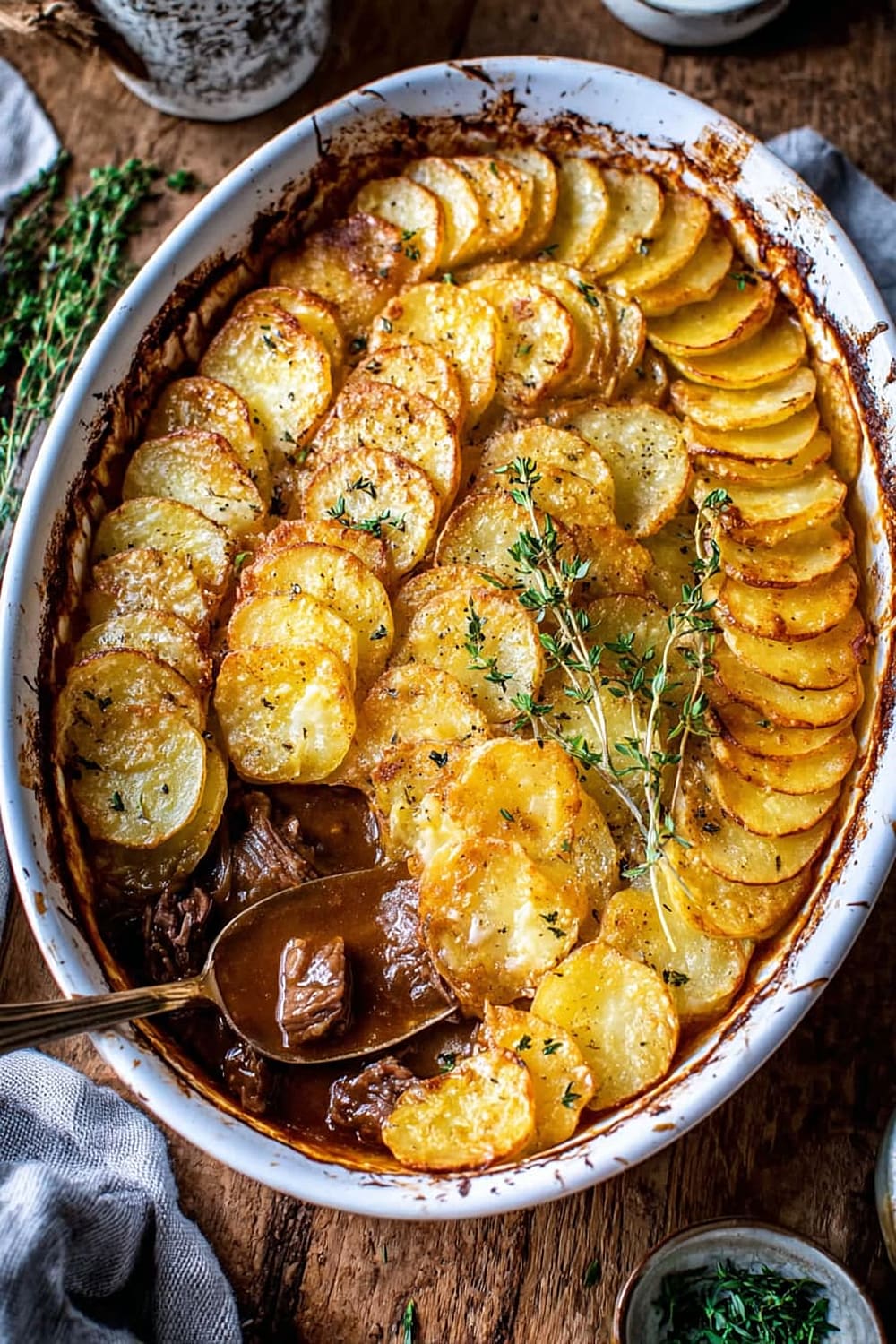
Common Substitutions:
- Lamb → Beef chuck roast or pork shoulder (same cooking time), chicken thighs (reduce cooking time by 30 minutes)
- Plain flour → Cornstarch (use half the amount) or arrowroot powder for thickening
- Fresh onions → 2 tablespoons onion powder mixed into the flour (though fresh provides better texture)
- Worcestershire sauce → Soy sauce plus a splash of vinegar for similar umami depth
Budget-Friendly Swaps:
- Lamb shoulder → Lamb neck or even beef stewing meat for more economical options
- Fresh stock → Quality stock cubes or bouillon paste dissolved in hot water
- Fresh carrots → Frozen carrot chunks (add directly without thawing)
Pantry Emergency Substitutions:
- Bay leaves → ½ teaspoon dried oregano or rosemary
- Fresh thyme → ½ teaspoon dried thyme or mixed herbs
- Butter → Equal amount of olive oil or vegetable oil throughout
Pro Tips for Substitutions:
- Store leftover stock in ice cube trays for easy portioning in future recipes
- When using cornstarch instead of flour, mix it with cold liquid first to prevent lumps
Make It Diabetes-Friendly
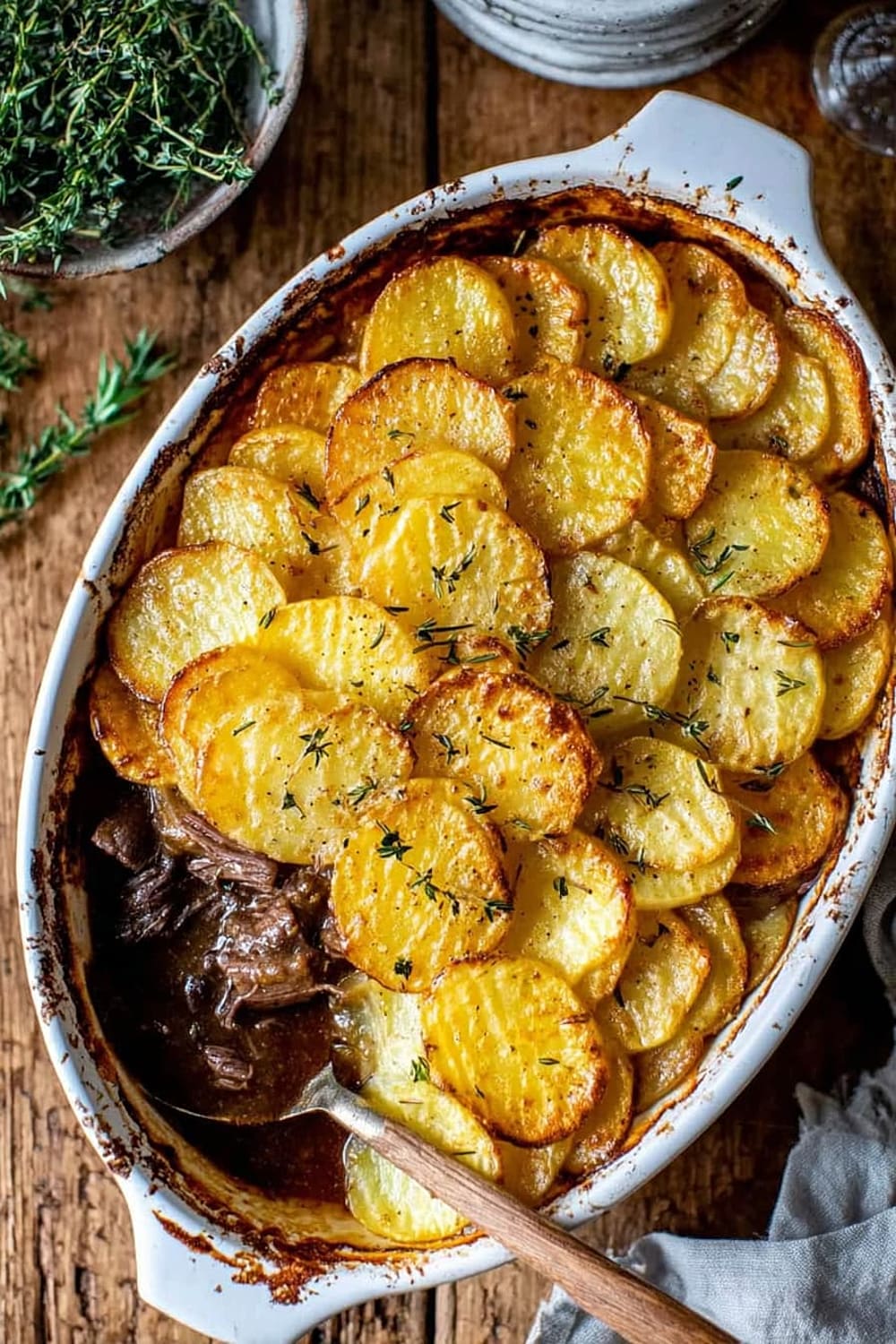
Carb Modifications:
- Replace half the potatoes with thinly sliced turnips or cauliflower for a 40% carb reduction
- Use cauliflower mash as a topping instead of sliced potatoes to reduce carbs from 35g to 12g per serving
- Increase the vegetable ratio – add extra carrots, celery, and bell peppers to bulk up the dish with fiber
Flour Alternatives:
- Substitute the flour with 1½ teaspoons xanthan gum mixed directly into the stock for thickening
- Use almond flour (2 tablespoons) for a low-carb thickening option that adds subtle nutty flavor
- Skip thickening entirely and allow natural reduction during cooking for a brothier consistency
Portion & Timing Tips:
- Recommended serving size: ¾ cup for approximately 18g carbs with potato modifications
- Pair with protein-rich sides like Greek yogurt or a small serving of nuts to slow glucose absorption
- Add extra fiber through a side salad with olive oil dressing to further moderate blood sugar impact
Total Carb Reduction: Modified version contains approximately 18g carbs versus 35g in the traditional recipe
Perfect Pairing Suggestions
Beverage Pairings
A robust red wine like Cabernet Sauvignon or Merlot complements the rich lamb flavors beautifully, while English bitter or brown ale provides that authentic British pub experience. For non-alcoholic options, sparkling apple cider or robust black tea echo the cozy, warming qualities of this comfort dish. Red grape juice mixed with a splash of ginger ale creates a festive alcohol-free alternative.
Side Dish Recommendations
Steamed green vegetables like broccoli, Brussels sprouts, or green beans provide fresh contrast to the rich, hearty hot pot. Buttered peas with fresh mint offer traditional British accompaniment, while braised red cabbage adds tangy sweetness that cuts through the savory lamb. Crusty bread rolls or oatcakes are perfect for soaking up any extra gravy.
Complete Meal Ideas
Start with a simple green salad with vinaigrette to cleanse the palate, serve the hot pot as your centerpiece, and finish with traditional British pudding like treacle tart or spotted dick. For casual entertaining, pair with pickled onions and crusty bread for an authentic pub-style meal.
Occasion Suggestions
Perfect for Sunday family dinners, cold weather gatherings, or casual entertaining where you want maximum impact with minimal fuss. Ideal for autumn and winter celebrations and pairs beautifully with fireside dining or cozy kitchen suppers.
Pro Tips and Troubleshooting
Professional Techniques
Always brown your lamb in batches if necessary – overcrowding creates steam instead of the caramelization that builds flavor depth. Pat lamb dry before browning for better searing, and don’t move pieces until they release easily from the pan. Layer potatoes with slight overlaps for that classic scalloped appearance, and brush with melted butter between layers for extra richness.
Common Mistake Prevention
Avoid cutting potatoes too thick – they won’t cook through properly and will remain hard on top. Don’t skip the resting time after removing from oven – the filling will be molten hot and needs settling time. Resist opening the oven during the first cooking phase, as this releases essential steam needed for tender lamb.
Storage and Reheating
Lancashire Hot Pot keeps beautifully for up to 3 days refrigerated and actually improves in flavor. Reheat gently in a 300°F (150°C) oven, covered, for 20-25 minutes. Freeze portions for up to 3 months – thaw overnight and reheat as above.
Make-Ahead Strategies
Prepare through step 6 up to 24 hours ahead, then add vegetables and potato topping when ready to bake. Pre-slice potatoes and store in cold water to prevent browning – drain and pat dry before using.
This traditional Lancashire Hot Pot proves that the most memorable meals often come from the simplest ingredients treated with respect and patience. The magic happens in that slow, gentle oven cooking that transforms humble lamb and potatoes into something truly special that’ll have everyone asking when you’re making it again.